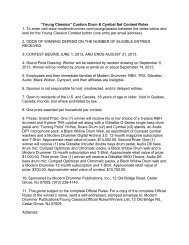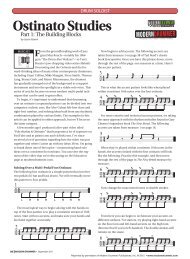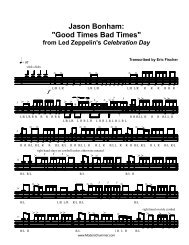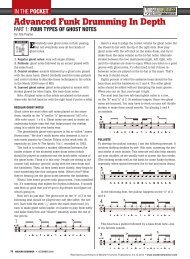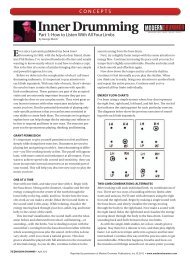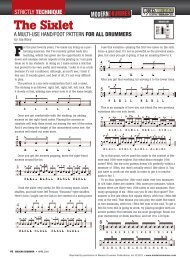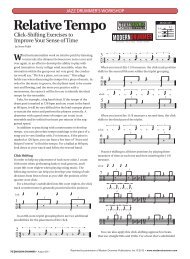Inner Drumming, Part 2 - Modern Drummer Magazine
Inner Drumming, Part 2 - Modern Drummer Magazine
Inner Drumming, Part 2 - Modern Drummer Magazine
You also want an ePaper? Increase the reach of your titles
YUMPU automatically turns print PDFs into web optimized ePapers that Google loves.
64<br />
Bryan Caldwell<br />
In my previous article (April 2012), I explained the concept<br />
of listening—or sounding—with each individual limb and<br />
the importance of practicing increased internal awareness of<br />
the energy flow from limb to limb. The exercises started by<br />
focusing on one limb at a time and then progressed to two<br />
limbs. The two-limb exercises incorporated both unisons<br />
and alternates.<br />
The next step is to work with three limbs at a time. There are<br />
four different three-limb combinations, as shown in the diagrams<br />
below. As before, I’m using a dot to represent the right<br />
foot (RF), right hand (RH), left hand (LH), and left foot (LF).<br />
THREE-LIMB DIAGRAMS: SEQUENTIAL<br />
We’ll start with the familiar grouping RF, RH, LH, as shown<br />
in the diagrams that follow. These are the three limbs we’ll<br />
be working with for the rest of this study. You can explore<br />
the other groupings on your own, using the same concepts<br />
presented here. (If you’re a lefty, use LF instead of RF<br />
throughout.)<br />
The circled dot indicates the starting point for each flow,<br />
and the arrow indicates the direction of the scan. Starting<br />
with RF, this grouping can be scanned in a counterclockwise<br />
direction (RF-RH-LH) or in a clockwise direction (RF-LH-<br />
RH). As with the single- and two-limb studies, take your<br />
time. Remember to give yourself permission to feel and listen<br />
deeply while doing these exercises. Incorporate internal<br />
awareness as an essential part of your sound.<br />
MODERN DRUMMER • June 2012<br />
CONCEPTS<br />
<strong>Inner</strong> <strong>Drumming</strong><br />
Listening With All Four Limbs, <strong>Part</strong> 2<br />
by George Marsh<br />
Reprinted by permission of<br />
<strong>Modern</strong> <strong>Drummer</strong> Publications, Inc. © 2012<br />
www.moderndrummer.com<br />
Bring your attention from the center of the earth to your<br />
right foot, and play a few strokes. Relax and scan from your<br />
right foot to your right hand. Play several notes. (I like to use<br />
the floor tom for right-hand strokes.) Move your attention<br />
slowly from the right hand to the left hand. Play several notes.<br />
Then scan from the left hand to the right foot. This helps<br />
establish the map of the particular sequence you’re playing.<br />
Next, play single strokes with each limb using the same<br />
sequence (RF-RH-LH). Let the tempo find itself, and then<br />
gradually increase it. Stay relaxed, grounded, and aware of<br />
the internal movement as you scan from limb to limb. When<br />
you feel it’s time, do the same with the clockwise direction,<br />
RF-LH-RH.<br />
THE PENDULUM RUDIMENT<br />
The counterclockwise and clockwise sequences can be combined<br />
to create what I call the three-limb pendulum rudiment.<br />
This six-note sequence is RF-RH-LH-RF-LH-RH. The<br />
thick and thin lines are used for visual clarity. I usually start<br />
with the thick line first, but you can start with the thin line if<br />
you wish, always following the direction of the arrow.<br />
This pendulum rudiment can have a total of three different<br />
starting points. It’s the same sequence, just starting at<br />
different places. Here are the other two.
There are two more pendulum rudiments in the RF-RH-<br />
LH triangle. Here’s one with the sequence RH-LH-RF-RH-<br />
RF-LH.<br />
As before, this sequence can have three different starting<br />
points. Here are the other two.<br />
Here’s the last pendulum rudiment based on the RF-RH-<br />
LH grouping. It has the sequence LH-RF-RH-LH-RH-RF.<br />
Again, the same sequence can have different starting<br />
points. Here are the others.<br />
THREE-LIMB DIAGRAMS: UNISONS<br />
Exploring unisons improves accuracy. Play RF, RH, and LH<br />
as one sound. Bring your awareness from the center of your<br />
belly to the three limbs simultaneously, and make a stroke.<br />
Continue the unisons until you minimize flamming. Let a<br />
slow tempo appear, and stick with it until it feels comfortable.<br />
Then pick a slightly faster tempo and work with it in the same<br />
way. Remember to listen to the three sounds as one.<br />
Next, alternate between RF and a unison combination of<br />
RH and LH. This is similar to alternating between two limbs,<br />
with the special case here being that the RH and LH are<br />
playing unisons. Continue with RH versus RF-LH unisons,<br />
and then play LH versus RF-RH unisons.<br />
THREE MORE<br />
This article has focused on the right foot, right hand, and<br />
left hand. There are three other three-limb combinations,<br />
which gives you a total of four.<br />
As you’re exploring these exercises, be sure to plug<br />
in your favorite rhythms. And have fun applying <strong>Inner</strong><br />
<strong>Drumming</strong> to your own practice. In part three, we’ll explore<br />
four-limb combinations.<br />
George Marsh is a San Francisco–based jazz drummer/composer<br />
currently playing with the David Grisman Sextet. He’s recorded with<br />
John Abercrombie, Terry Riley, Jerry Garcia, Pauline Oliveros, Denny<br />
Zeitlin, Maria Muldaur, and others. Marsh has taught at the<br />
University of California at Santa Cruz and at Sonoma State University<br />
since 1982, and he maintains a private studio in Santa Rosa,<br />
California. For more info, visit marshdrum.com.<br />
Reprinted by permission of <strong>Modern</strong> <strong>Drummer</strong> Publications, Inc. © 2012 www.moderndrummer.com<br />
June 2012 • MODERN DRUMMER 65



